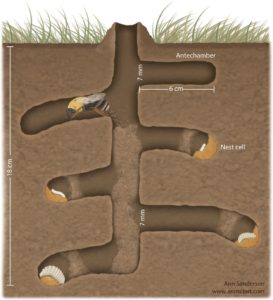Hoary squash bee (Eucera pruinosa)

Caption: Hoary squash bee nesting diagram from https://www.nature.com/articles/s41598-019-47805-1/figures/1
Credit: Permission granted from Ann Sanderson and Susan Chan to use graphic
To view the photo-rich magazine version, click here.
Originally appears in the Summer 2022 issue.
By Susan Chan
This wild bee shows an unusually high degree of specialization by depending entirely on Cucurbita crops for pollen. Each hoary squash bee female builds her own nest in the ground, typically within the field areas growing pumpkins, squash, and gourds (Cucurbita crops). These would be the same areas where systemic pesticides called neonicotinoids are often applied as soil drenches or seed treatments. This means that the squash bee could be exposed to pesticide poisoning from the soil itself and from the pollen and nectar it harvests from the crops. Research conducted by me and Nigel E. Raine at the University of Guelph found that when the bees were exposed to a crop treated at planting time with soil-applied imidicloprid (a neonicotinoid), the squash bees built 85% fewer nests, left 5.3 times more pollen unharvested and produced 89% fewer offspring when compared to exposure to crops planted with untreated seeds.
This content is restricted to subscribers only.
If you are not yet a subscriber, please consider taking out a subscription here.
If you are an existing subscriber, kindly log in or contact us at info@greenteacher.com for more information.










